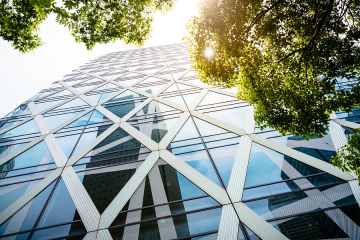Due to COVID-19, many office buildings, retail locations and manufacturing facilities are sitting unoccupied. This downtime presents an opportunity to carry out facility optimization, preventive maintenance or repair tasks.
Due to COVID-19, many office buildings, retail locations and manufacturing plants are closed or operating at reduced capacity. Savvy building operators may have shifted their building systems into unoccupied mode to save energy and water expenses. This downtime presents an opportunity to carry out facility optimization, preventive maintenance or repair tasks that may have been postponed. As companies prepare to restart operations in the coming weeks and months, it is important to operate the facilities as efficiently as possible to reduce operation expense and protect the environment. To help you achieve these goals, we’ve compiled the following tips to re-calibrate equipment and systems for optimal performance in your facility.
Building Systems Operation
Start by reviewing the alert/fault event logs in your building’s energy management system (BEMS, also known as BAS, Building Automation System). Were all the root causes of the occurrence identified? Were all the necessary adjustments and repairs completed? Next, look through the system and verify the space temperature setting has not been overwritten. Do you have one zone with a higher than typical heating setpoint? Look for the reason why the setting was overwritten. Was it to address a cold/hot call? If the issue was resolved, adjust the setpoint back to its original setpoint. Lastly, look for HVAC equipment that has been put in manual over-ride mode or is not reporting status to the BEMS. Understand why it was put in manual mode, correct the problem and bring the system back under BEMS control. For equipment that is not reporting status to the BEMS, make a list and inspect the individual equipment to resolve the issue.
Conduct a Facility Walk Through
Carrying out regular walk throughs of your facility when the facility is in unoccupied mode is another useful technique carried out by top-performing building operators. If not already in unoccupied mode, use the BEMS and set the building energy system to unoccupied. In this mode, there should be minimal or no HVAC equipment operating. This is a good time to walk through the facility to look, listen and feel for energy saving opportunities. Start from the bottom of the building and work your way to the top. Use the following guide to help identify potential savings.
Heating, Ventilation and Air Condition (HVAC)
At each space you walk through, check the thermostats’ temperature reading and verify it is accurate within reason. Sensors that are out of calibration waste energy by calling for heating and cooling when it is not necessary or fail to provide heating and cooling to keep the occupant comfortable. Repair or replace faulty thermostats as necessary. Cross check your list of equipment that is not reporting status to the BEMS and make sure you inspect that equipment.
During inspection, be sure to listen for sounds and feel for air movement that indicates equipment is running. There may be equipment put in manual override and not reflected on the BEMS. Address the cause for the overwrite and ensure the communication to the BEMS is re-established.
As companies recover from the COVID-19 pandemic, it is important to keep workplaces safe. At each air handing unit, check the cleanness of the air filters and ensure the proper operation of the air dampers, especially the outside air. According to ASHRAE, the combination of proper ventilation and air filtering is key to maintaining good indoor air quality. Studies conducted by national labs and others suggest a UV germicidal irradiation (UVGI) system could further improve indoor air quality. Review ASHRAE’s COVID-19 information page for additional information on maintaining good indoor air quality.
Lighting
Turn on lights as you walk through each space to identify burn-out lamps and replace them. Also, listen for buzzing noises from light fixtures or other electronic equipment. Trace the sound to its source and address the issue. Walk in and out of spaces that have occupancy or vacancy sensors installed to verify they are working as designed, replacing and adjusting as needed. After completing your light checks, there should be a minimal amount of lighting needed in an un-occupied building. Shut off lights from the central lighting control system or manually turn off lights as you walk through the facility. Ideally, building operators should come back to the facility at night to verify un-necessary lights are still off.
Building Envelope
Envelope leakage is easier to detect when the HVAC systems are offline, and the building is unoccupied. Walk along the building perimeter, looking and feeling for airflow and follow the air. Are there gaps between the doors or at the bottom of the door? Repair gaps as necessary to eliminate air infiltration to reduce heating and cooling energy use and reduce infiltration of air pollutants.
Hot air rises, so the warm indoor air will naturally exit the building at the top through leaky air dampers or failed damper actuators (leaving the dampers partially open). Feel for air movement around the elevator shaft and the stairwell. Eliminating air leakage will reduce energy usage and ensure the building is properly pressurized. In a distribution center such as a refrigerated warehouse, check the loading dock door seals. Within a facility, check the conditioned vs. non-conditioned spaces’ doors and walls. Warm and moist air infiltrated into refrigerated spaces causes refrigeration equipment to work harder, thus wasting energy.
Plug Loads
As you walk through the facility, pay attention to plug load as well. Specifically, look under the desk for space heaters or other electronics such as computers or task lights that are left on at desks. Note the spaces that have space heaters and come back to address HVAC comfort issues when the occupant returns.
Water
In each restroom, kitchen area, and janitorial closet, listen and look for any indicators of a water leak. Small leaks have the potential to become expensive repairs, sometimes even causing the building to be inhabitable. If you have water sourced heating and cooling equipment, look at the floor around each unit for signs of water leakage. For overhead equipment, are there water stains on the ceiling tiles? An infrared camera could be used to scan the floor and ceiling area to identify damp vs. dry areas.
Manufacturing
During your walk through, look and see if there are conveyor belts left on when no product is moving through the production line. Can the conveyor system be shut off? Is there production support equipment, such as air compressors, that can be shut off? This is also a great time to walk the compressed air line and identify and repair air leaks.
In closing, it is important to operate facilities as efficiently as possible when they are occupied. And right now is the ideal time to identify facility optimization opportunities as facilities sit unoccupied. The above outlined tips are a good place to start.
Learn more about our Facility Optimization services and how we can help you enhance the sustainability and business resiliency of your facilities and assets.
Download our Facility Optimization Resource Reduction Assessment
Antea Group's Facility Optimization Ebook
Download Antea Group’s ebook to learn strategies that will optimize the sustainability and business resiliency of your facilities and assets.
Download NowWant more news and insights like this?
Sign up for our monthly e-newsletter, The New Leaf. Our goal is to keep you updated, educated and even a bit entertained as it relates to all things EHS and sustainability.
Get e-NewsletterHave any questions?
Contact us to discuss your environment, health, safety and sustainability needs today.






